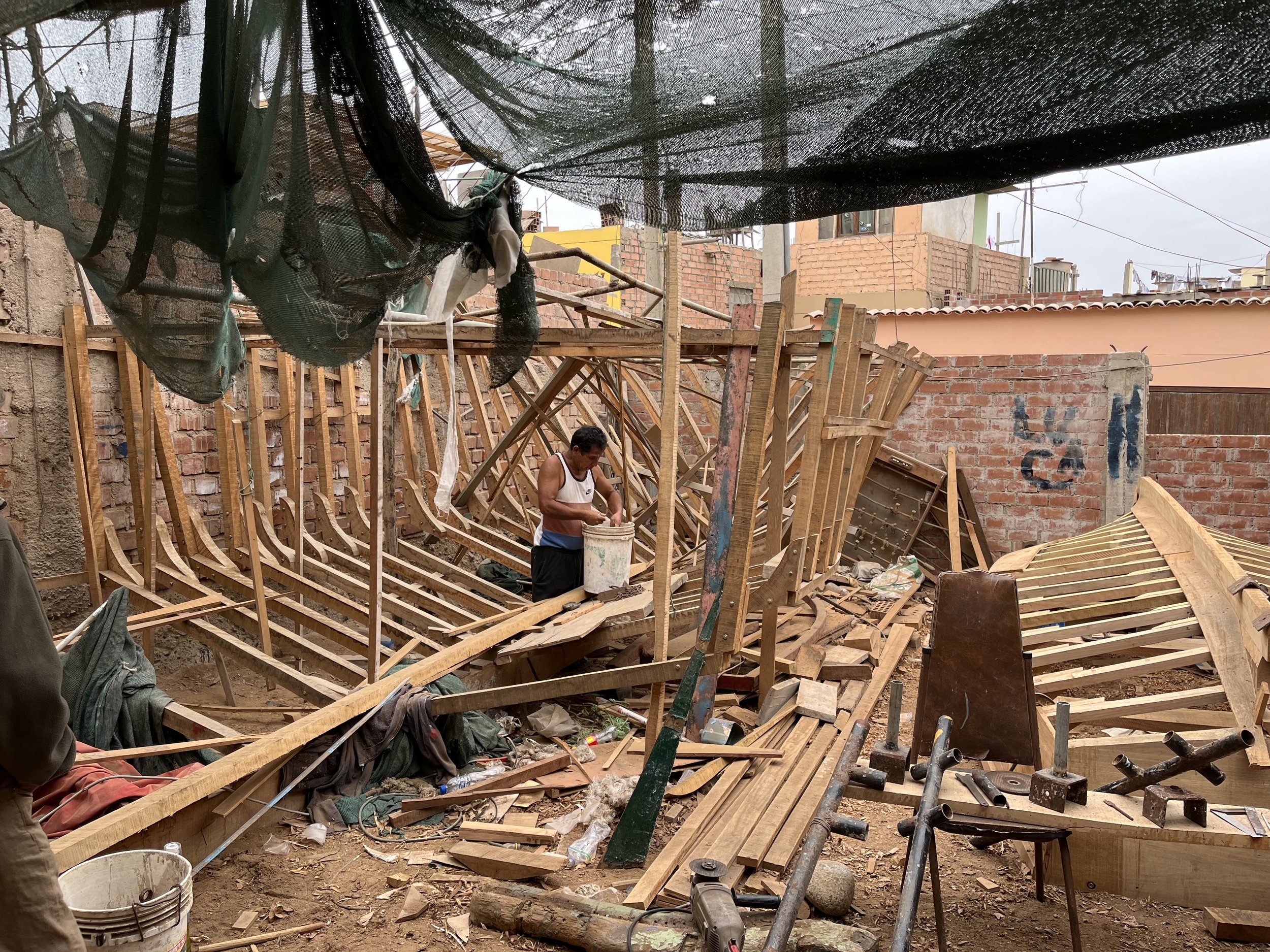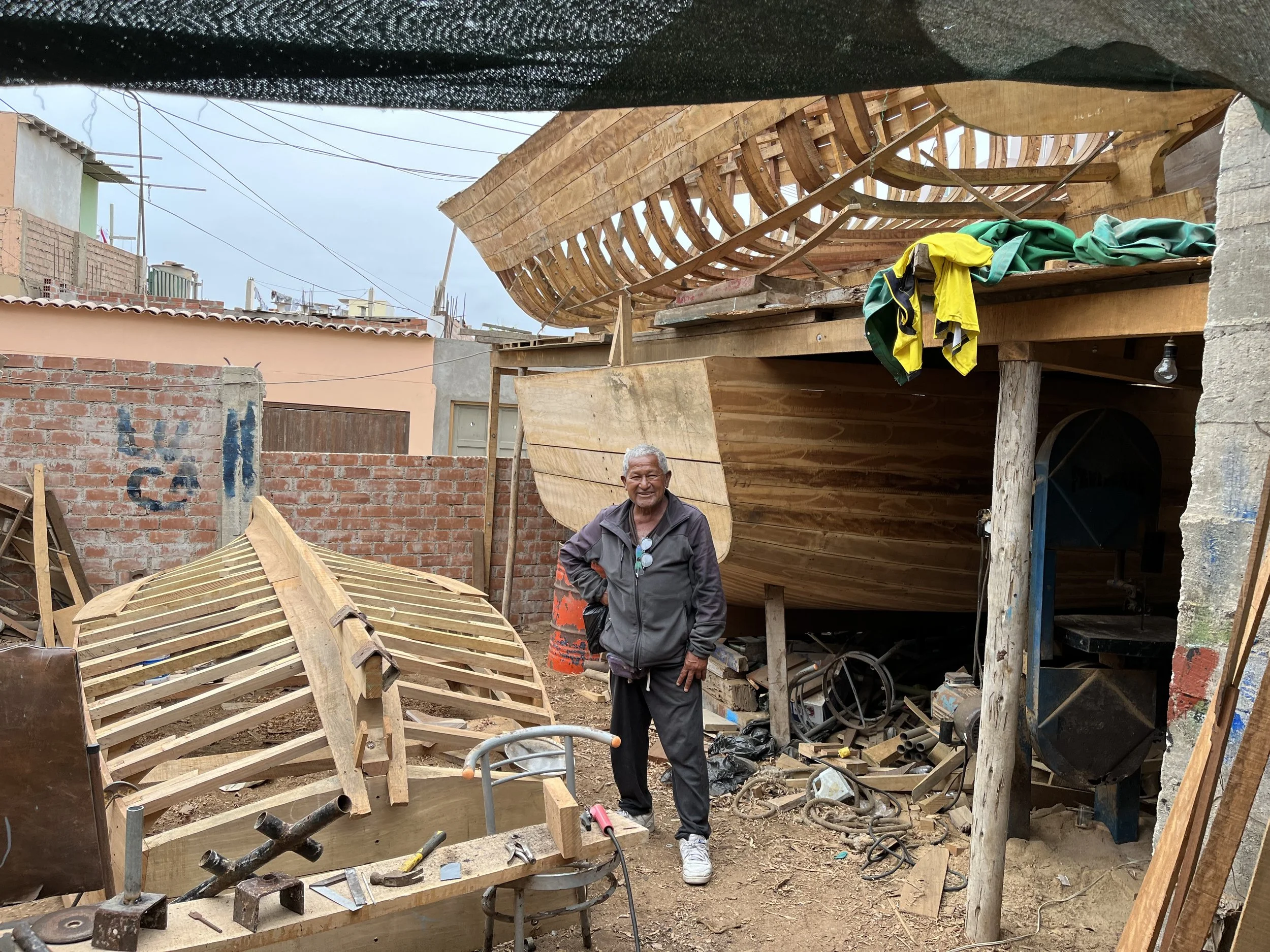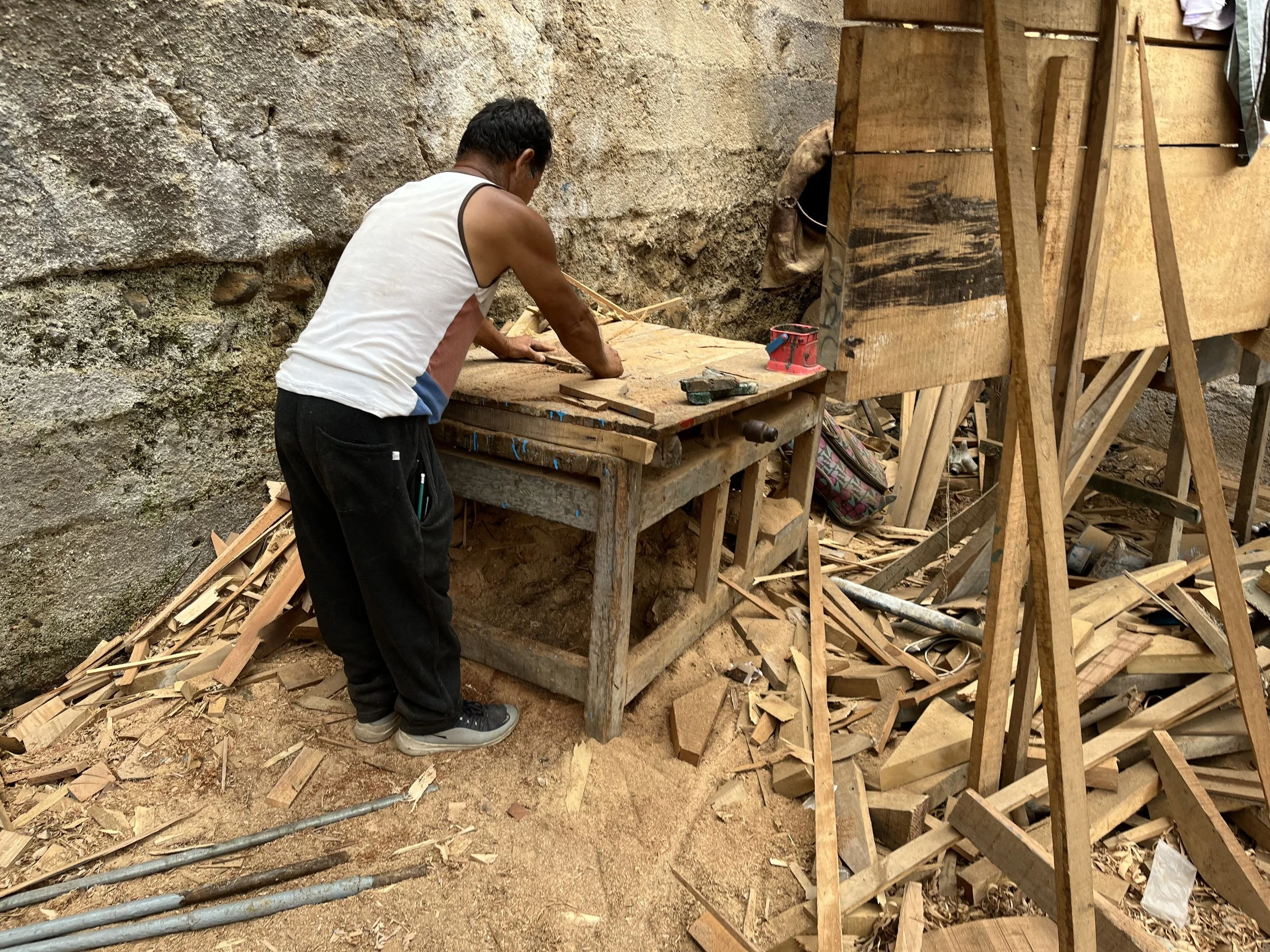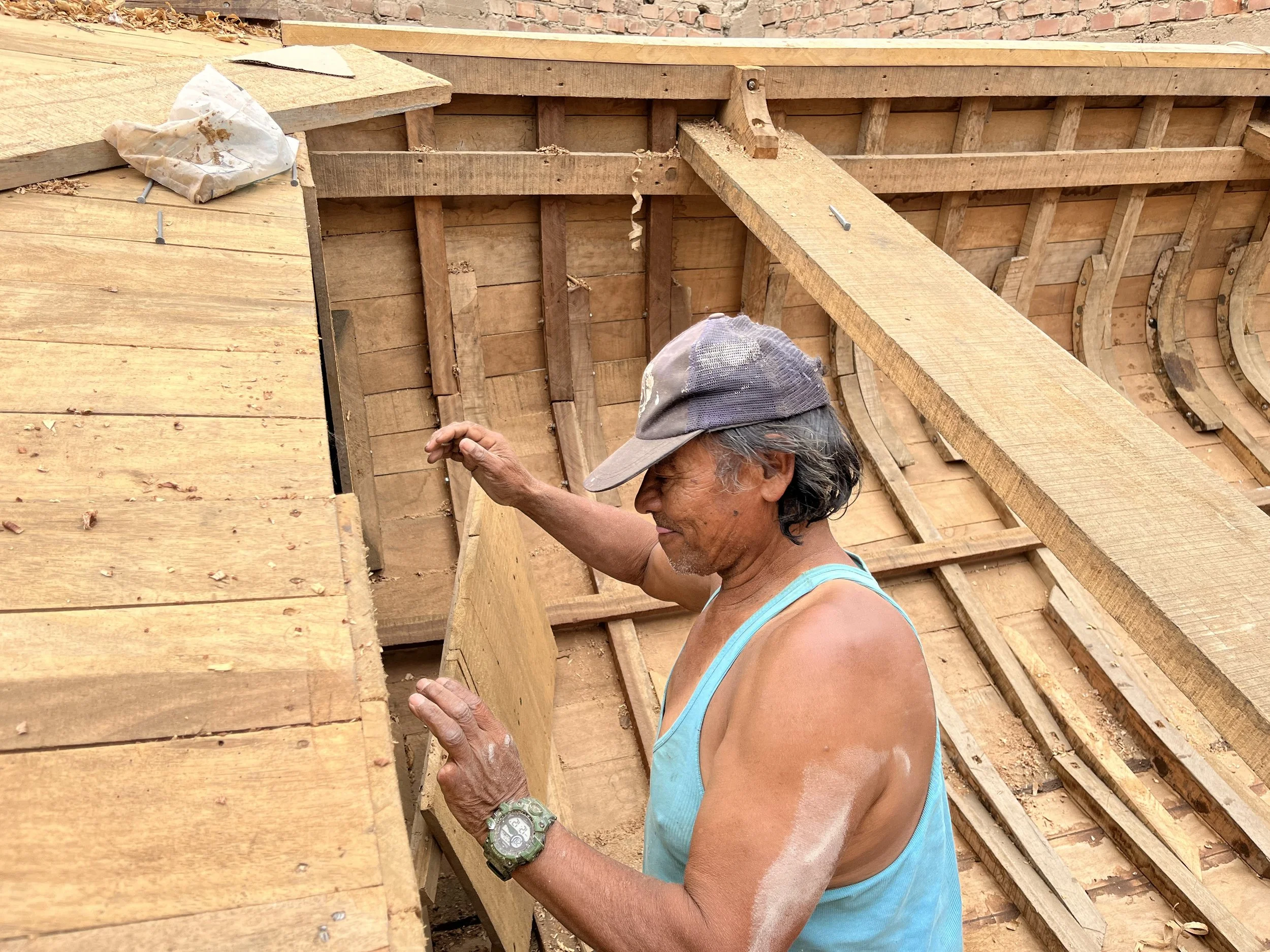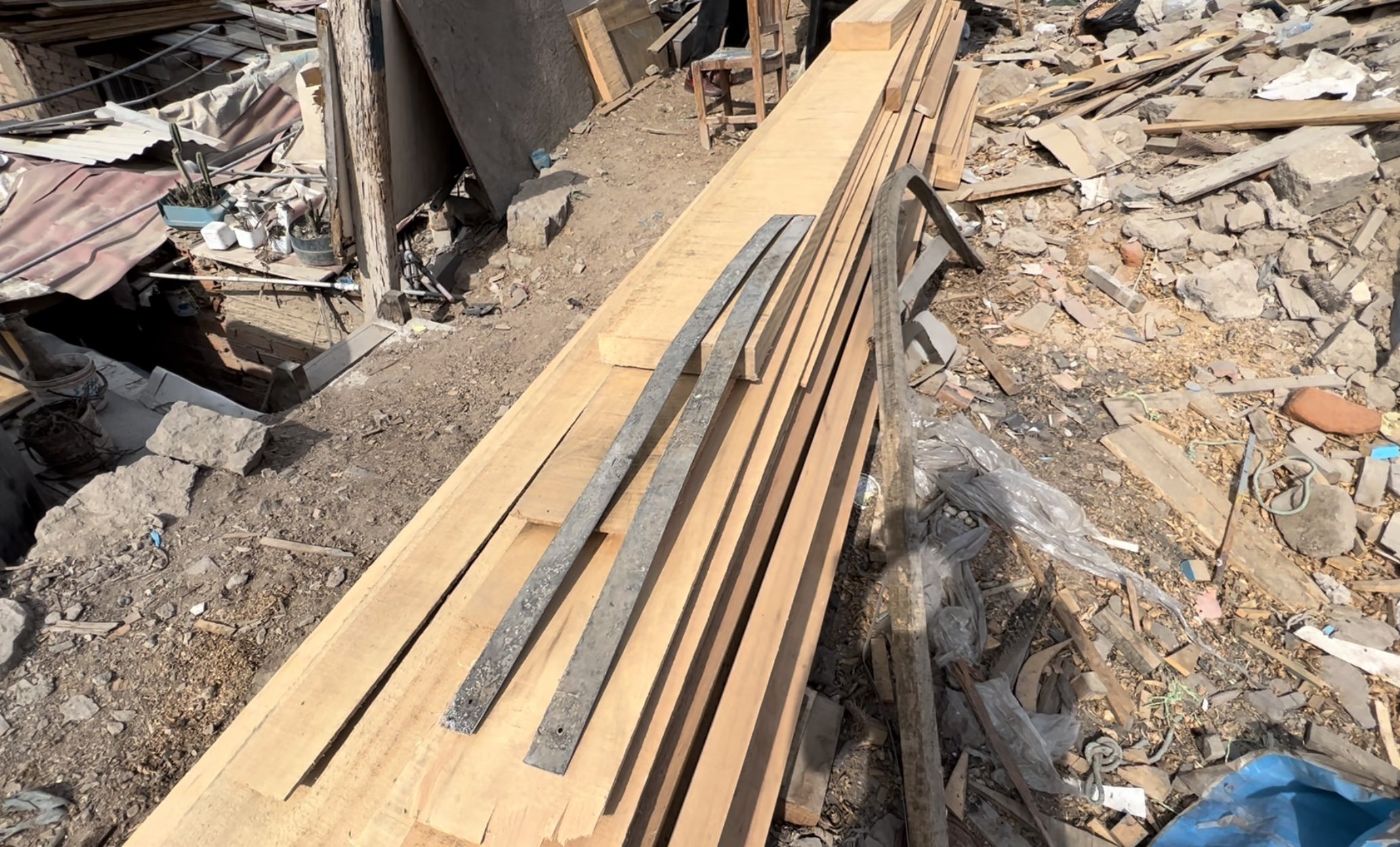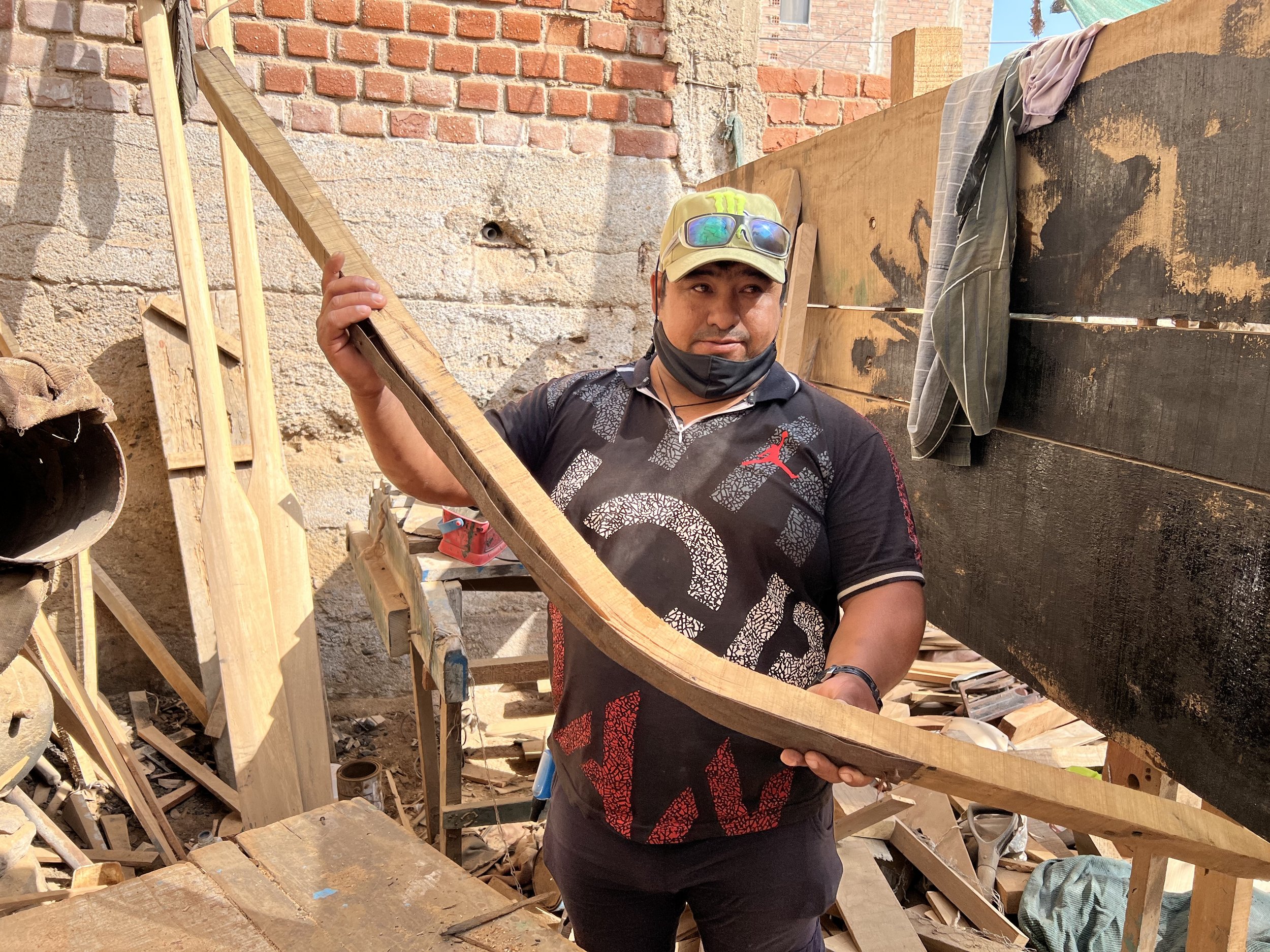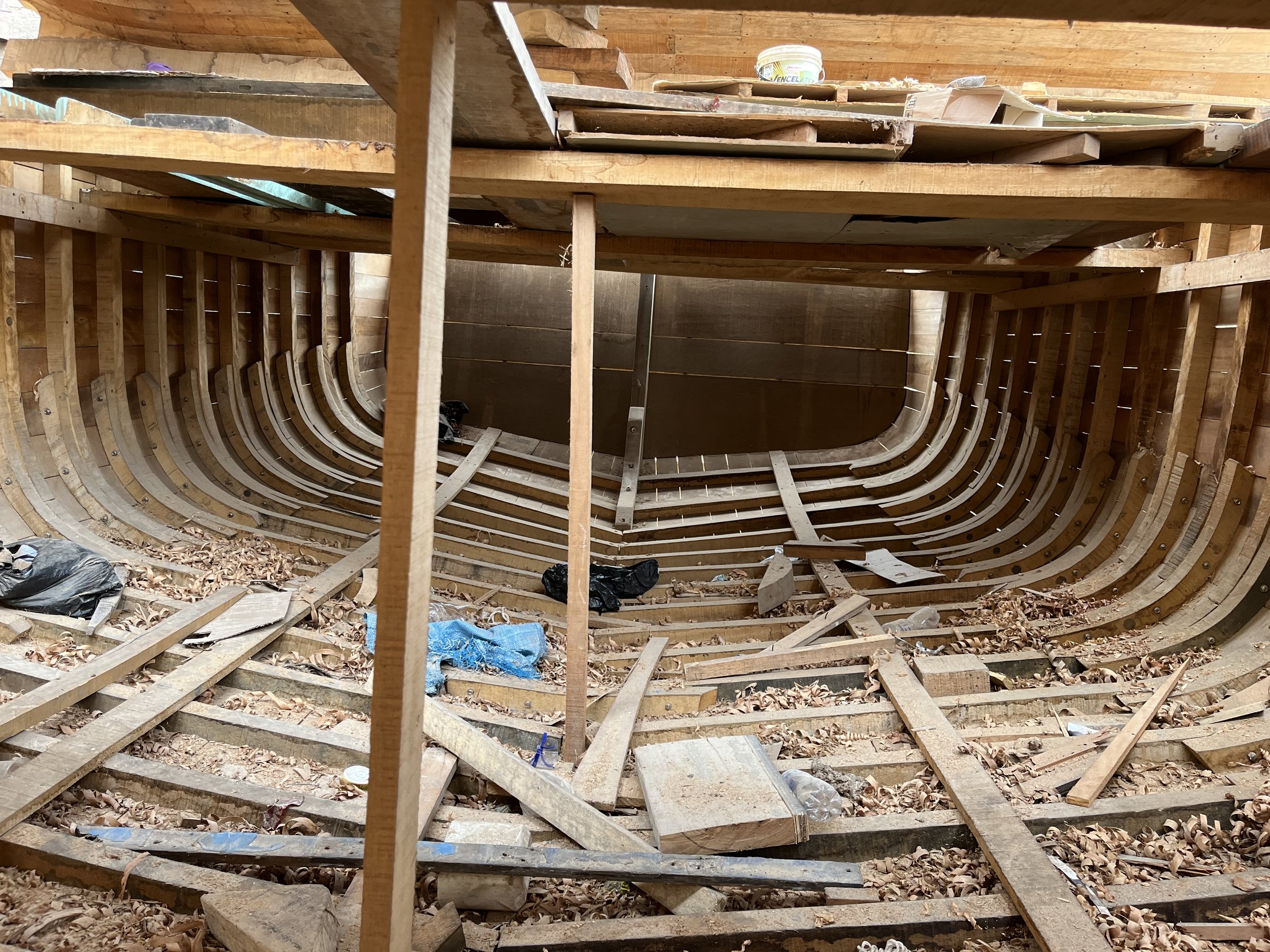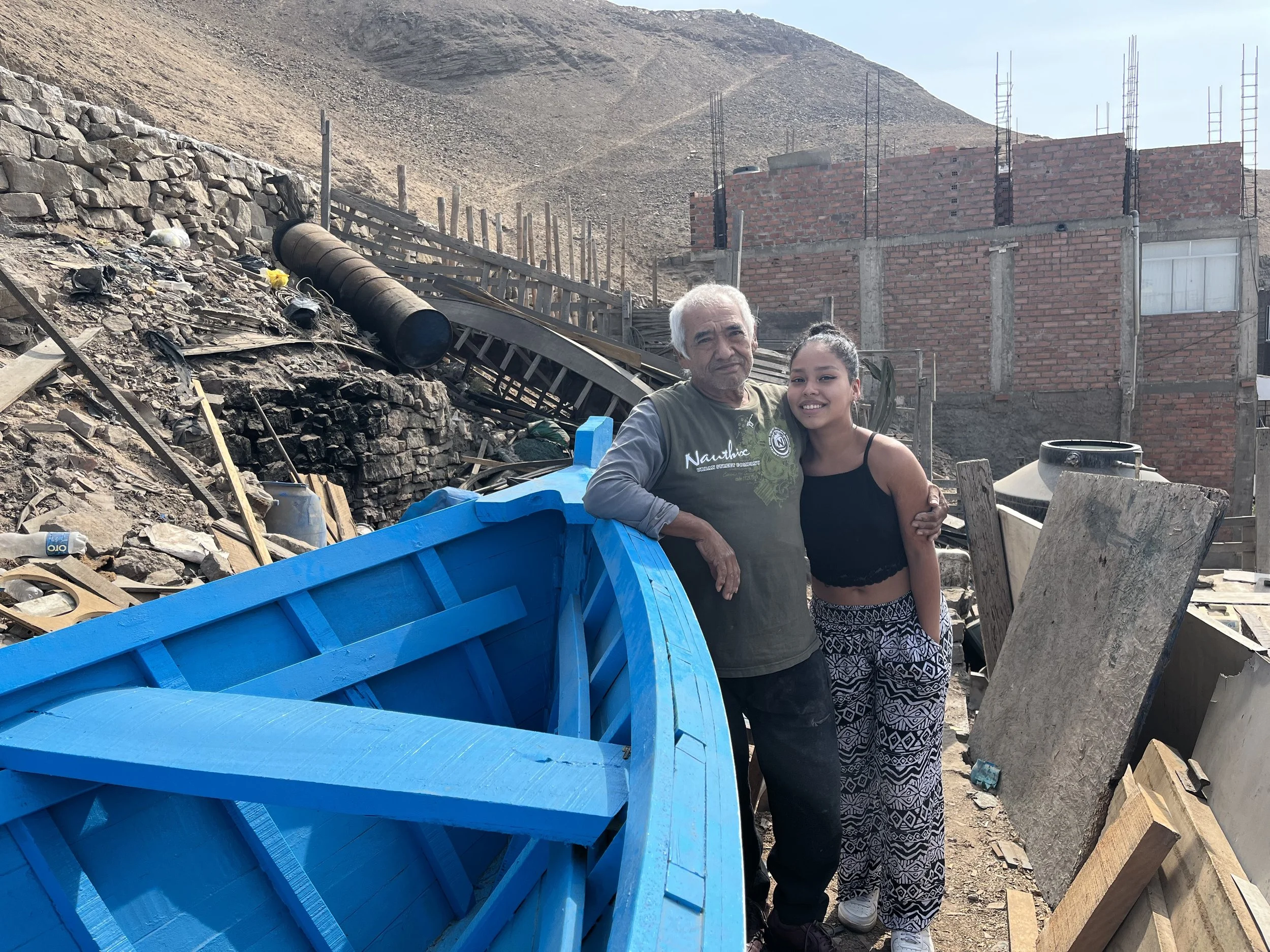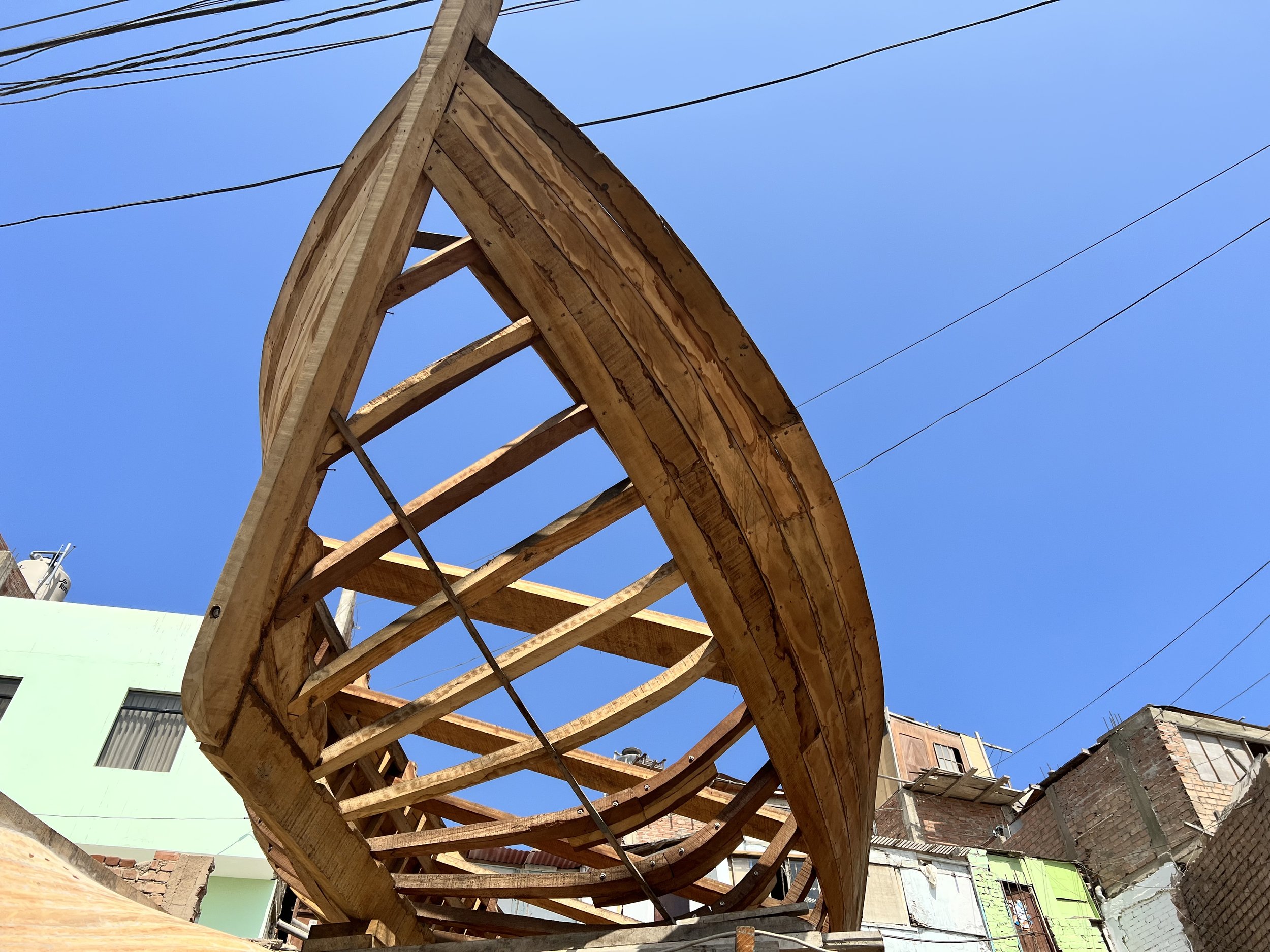Peruvian Traditional Boats Part 4
Now that we’ve learnt about the different types of Peruvian fishing craft, we’ll walk back up the hill and revisit the boatbuilders who are maintaining and renewing the fleet. Keep in mind, these men are not traditionalists, nor romantics, they are hardworking tradespeople, sweating each day to make a living, and a meagre one at that. Since my first visit to the boat yard, I have been back twice, unfortunately both times the boatbuilders were away. The store keeper next door informed me that they have gone down south for a month to work on a bigger boat, so my observations below are somewhat limited. Luckily, we’ll also get to visit another boatbuilder, a humble old man who lives further up the hill. He’s both a boatbuilder and a fisherman, and he’s just finished building a fine dinghy.
As I mentioned in part one, the boatyard I visited was an amazing place, a proper old fashioned establishment. There were five boats under construction, two men working. On the ground floor, as we will now refer to it, there were three boats being built, all in different stages. The most complete was a sawn frame, transom sterned motor boat, she was fully planked and the hull had had it’s initial (or perhaps final) fairing with the angle grinder. I would guess some caulking will come next, but who knows? On your right as you walk in is a vee-bottom dinghy, she’s upside down and the bottom has a couple of planks on each side, from this angle it looks like she’ll be a fine craft. Next to this dinghy, against the far wall, is a large chine vessel who’s construction has just begun. The keel is down, the stem and transom are erect, and the frames are starting to go up. This one looks to be of a similar size to the beamy round bilge boats. I could be mistaken, but I believe the boatbuilders were trying to explain that the chine boat is actually more expensive than it’s round bilge cousins, there’s more work in making the frames, chine etc. The advantage being the added stability gained from the chine.
Also on the ground floor, along with the three boats under construction, was the woodworking machinery. To my astonishment there was a small bandsaw and a very rudimentary table saw; that was it. I’m used to a boat shed with dropsaw, thicknesser, jointer, large and small bandsaws, fancy tablesaw etc. Not in this boat yard. The bandsaw was just big enough to get out a futtock, no more. The table saw was a wonky, square topped timber affair, no fence on this saw. It’s most interesting feature was a horizontal chuck that protruded from under the right hand side of the table, running off the same shaft as the saw blade. I assume that this is a handy addition that has many uses. My only guess involves a detachable grind stone that can be used to sharpen blades. I also saw a welder and a circular saw. I assume they would have electric plane, electric drill and angle grinder. I saw a hand saw, some old chisels and a jack plane. Surely a boat can’t be built with just these. I asked the men if they had any more tools. They chuckled and shook their heads.
We’ll now climb up a few rungs of the makeshift ladder, to the second story, the open air mezzanine, if you will. This level is actually just a few sheets of fibre board, just enough for two sawn frame vessels. With a bit of ducking and weaving I found myself between the two boats. The first was about a quarter planked up, the other was almost complete. There was a fellow on the inside of this boat fitting boards to the forward storage chamber. As I peeked over he was about to plug in the vacuum cleaner to suck up the shavings from his plane. You ought to see this. At the end of the vacuum cleaner cable, where one would expect to find a plug, there were two wires, on both the insulation was stripped back to expose the shiny copper. The boatbuilder then picked up the extension lead, and proceeded to insert the wires into their corresponding holes, sparks and all! I went home and googled it, they’ve got 220v here. Life and death boatbuilding. Behind the two boats that were perilously placed atop the makeshift structure was another sort of level, and atop this was a fine wheelhouse, it looked to be recently completed. There’s no plywood here, the shapely house was constructed from vertical boards. This wheelhouse led me to believe that the largest boat being built here, the one protruding above the front wall, will be quite a substantial vessel. I didn’t see any boats with wheelhouses moored at Chorrillos, however, there were plenty moored some miles further north in a fishing and tourist town called Ancon. Perhaps this vessel was destined for Ancon.
The two men here work away purposefully and efficiently. I am led to believe that this establishment is at least 2 generations old, probably more. The skills have been passed down from father to son. New boatbuilders are trained informally, they are qualified when the master says so; maybe three years, maybe five, depending of course on the skill of the apprentice.
I was very curious about the design process; were their plans, half models, was it all by eye? Well, it goes something like this. The customer comes to the builder and asks for a boat, the boatbuilder and owner then collaborate on the exact shape wanted, no two boats are the same. Every owner has their personal opinion on the ideal shape. The builder does a drawing, and if the owner is happy, construction can commence. I would love to see one of these drawings…is it a sketch on the back of a napkin? A detailed linesplan? I assume it’s more the former than the latter. I explained that in Australia we draw the boat out full size on the floor after the design is finalised, to get accurate measurements. The builder laughed and shook his head, he knows how to cut and bend the frames to suit his drawings, very efficient indeed.
Which brings me onto the next topic, heat assisted bending, or steaming. The boatbuilders in Lima manage to get considerable bends out of their framing stock. The timber here is not steamed but rather, boiled, in a similar fashion to boatbuilders all around the world. With a metal tube on a 45 degree angle, plugged at one end and covered with heshen sacks at the other, a fire is lit beneath, heating the water inside. This fire roars along for five or six hours, until the frames are supple enough to take the required curve. What was most surprising was the use of a very thin metal strap during this process. When cold, I assume, the 2 foot long strap is nailed, once at each end, to what will be the outside of the frame. When it comes time to bend the frame the metal strap supports the fibres as they are stretched, which prevents breakage, pretty cool I thought.
The backbone structure and frames of these boats are of a hardwood species, a eucalypt. The planking is a medium density timber, let’s call it a softwood. Just like so many boat yards around the world, the customer has the choice between the standard planking softwood, and lighter cedar, at extra cost. It seems some things are universal. The sawn frames are fastened with stainless bolts, something the boatbuilders are very proud of. The planking, and everything else for that matter, is fastened with good old fashioned galvanised boat nails. Interestingly, the big boats are planked with the same thickness stock as the small dinghies. This seems odd to me, but I figure there’s a reason. The planking on the dinghies is probably over engineered, but thinner planking stock might not be easily available, and thinner stock requires higher quality timber. For the bigger boats the relatively light skin would make the process of planking much easier, especially with the full, flared bows. I don’t think these boatbuilders steam planks.
As I’m sure you can imagine, these boats are very cheap in comparison to first world prices. The boatbuilders here call themselves carpenters, so work like caulking, painting, motor instillation etc. is outsourced and comes at an extra cost. So, for a vee-bottom dinghy, it’s going to cost about $800 usd, with caulking and painting about $1000. Oars are $90. The larger boats are around $7000 usd. It takes about 3 months to complete a boat, these boatbuilders are well honed in their craft.
Now we’ll go for a walk, further up the hill. It’s just you and I today, Joaquin is back at work. Yesterday the storekeeper next door told me there was another boatbuilder up the street and around the corner. He scribbled some Spanish on a piece of paper and sent me on my way. So the next day I set off up the street, I turned at the first right and kept climbing until I reached an impoverished dead end. There was a guy and two girls sitting on the footpath, he was doing his best to impress them. He turned towards me, he said something stern in Spanish. I handed him the note, he smiled and nodded. He went to fetch someone while I waited behind a metal gate and an angry dog. Then appeared an old man who ushered me through the gate, the dog abated. We walked through a cluster of rickety concrete and tin homes, then up some steep steps, to a dirt terrace on the side of the hill, overlooking the impoverished urban sprawl. Here lay a fine new fishing dinghy, it looked ready for launch. The boatbuilder and I took off the tarpaulins, she was a nice boat, similar in dimensions to the vee-bottom dinghies, but built with heavy, steam bent frames. She was much more shapley than her chined counterparts, although her form was determined more by the curve the frames took, then the moulds they were bent around. There was an obvious kink in the hull on the portside where a frame had creased, otherwise, she was a sweet vessel.
We spent some time measuring this boat, and communicating. I imagine it would have been quite a funny experience for the old man, as it was for me. His granddaughter came up to see what was going on, she enjoyed watching me drop my pencil into the bottom of the boat, retrieving it moments later only to lose it again, often behind my ear or in my pocket. On this little terrace there were few boatbuilding implements. I saw two stacks of timber, two more boats I assume. I also saw a steaming tube, made from multiple 44 gallon drums welded end to end. There was a flock of metal straps laying around, the ones used to when bending frames. There was also a large frame like jig, it looked old. This was used to bend the frames to the correct curvature. I assume that the shape formed by using this mould is the midship section. The mould is then used to differing degrees to get the required shapes for the other frames. I wonder if all the boats he builds are the same shape? I bet he’s been doing it for many years now. I stayed a little while longer then went on my way, before leaving the old fisherman showed me the brand new nets in his home, to accompany his new boat I assume.
Just like the Peruvians themselves, whose DNA has been influenced by hundreds of years of conquest and immigration, their fishing boats too are a beautiful combination of the many ingredients that go into the melting pot that is Lima. However, whenever I asked a fisherman about the design of his boat, the response often came back “Italian”. A few hundred Italians came to Lima between 1532 and 1560, at this point there would have been reed boats on the beach. The first large wave of Italian migration came between 1840 and 1866, approximately 15 000 Italians, many of whom were fisherman, settled in Lima. With them they brought their knowledge and expertise in boat design, building and fishing. It was a lightbulb moment when I first heard a Peruvian fisherman say ‘Italian boat’. Of course! The lineage was obvious. So, these boat’s we’ve mentioned, from the punts to the double enders, the beamy and the narrow and everything in between, owe their genesis to the hardworking Italian fisherman who now, due to the wonders of this multicultural society are Inca/Spanish/Italian fishermen; a fine breed indeed. We could learn a thing or two from our friends the boatbuilders and fisherman of Coastal Peru.
So here ends our time with the boats and boatbuilders of Lima. This is, of course, just a brief swipe at a thriving and beautiful industry, there is much to learn still, not just here, but up and down the length of Peru’s coast. The little industry at Chorillos and La Punta that contributes in only a small way to making Peru the sixth largest fishing nation in the world, more than makes up with it’s traditional fleet of beautiful boats that add to the rich culture that defines this beautiful country.
